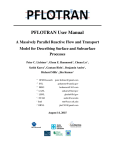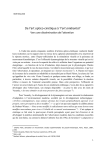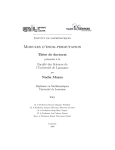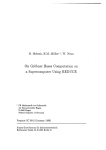Download Gröbner Basis and Applications – A Survey
Transcript
Gröbner Basis and Applications 1
– A Survey
1
Introduction
All the polynomial ideals are associated with varieties. To operated with
ideals, we will need to illustriate the computation of the basis of the ideal.
Hironaka in 1964, see [Hir], established the existence of the standard bases
for the local properties for the ideals of formal power series. However it was
Buchberger who, in his Ph.D. thesis, see [B1], first presented an algorithm
to perform the required transformation in the context of polynomial ideals
in the global cases.
What is a Gröbner basis ? The Gröbner basis is a finite set of multivariate
polynomials solves the following problem (see [B4]) :
• given a finite set F of multivariate polynomials over a field, construct
a finite set F 0 of multivariate polynomials such that ≡F =≡F 0 and →F 0
is Church-Rosser.
Where, for a set F of polynomials, ≡F is the ideal congruence modulo the
ideal generated by F (i.e. f ≡F g ⇔ f − g ∈ ideal(F )) and →F is a
certain Notherian reduction relation on polynomials introduced by F with
the property that the reflexive-symmetric-transitive closure of →F is equal to
≡F . If F 0 is the Gröbner bases of F , the Church-Rosser property guarantees,
that for arbitrary polynomials f, g the congruence f ≡F g can decided by
computing normal forms of f and g modulo →F 0 and checking for syntactic
equality.
A Gröbner basis is used to describe an ideal F := (f1 , . . . , fm ) of the polynomial ring k[x1 , . . . , xn ]. It permits us to determinate, if a given polynom
f belongs to F , and if not, to calculate his remainder modulo F . Let k[x]
be an univariate polynomial ring, let F := (f1 (x), . . . , fm (x)) be an ideal.
With the Euclidian algorithm, it is easy to reduct a given polynom f (x).
This method is based on the natural notion of ordering of terms in
polynomials. For a multivariate polynom, there doesn’t exist such a natural
order.
1
c MMXI : Permission to copy is granted provided the title page is also copied.
1
2
Problems concerning the algebra of polynomial
ideals and geometry of affine varieties
Below we summarize some those problems of Gröbner basis that are used in
the subsequent applications, (see [BCK] and [CLO]).
Problem 1
The Ideal Description Problem : Does every ideal I ⊂ k[x1 , . . . , xn ]
have a finite generating set ? In other words, we can write I = (f1 , . . . , fs )
for some fi ∈ k[x1 , . . . , xn ] ?
Problem 2
The Ideal Membership Problem : Given f ∈ k[x1 , . . . , xn ] and an ideal
I = (f1 , . . . , fs ), determine if f ∈ I. Geometrically, this is closely related to
the problem of determining whether V (f1 , . . . , fs ) lies on the variety V (f ).
Problem 3
The Problem of Solving Polynomial Equations : Find all common
solutions in K n of a system of polynomial equations
f1 (x1 , . . . , xn ) = . . . = fs (x1 , . . . , xn ) = 0
(This is the same as asking for the points in the affine variety V (f1 , . . . , fs ).)
Problem 4
The Problem of Implicitization : Let V be a subset of K n given parametrically as :
x1 = g1 (t1 , . . . , tm )
...
xn = gn (t1 , . . . , tm )
If the gi are polynomials (or rational functions) in the variables tj , the V will
be an affine variety or part of one. Find a system of polynomial equations
(in the xi ) that define the variety.
Note that problems 3 and 4 are inverse problems.
2
3
Orderings on the monomials in k[x1 , . . . , xn ]
Let X α := xα1 1 . . . xαnn be a monomial , where X := x1 . . . xn and α :=
(α1 , . . . , αn ) ∈ IN n . We note that we can reconstruct the monomial X α from
the n-tuple of exponents α. This establishes a one-to-one correspondence
between the monomials in k[X] and IN n
Definition 1 An ordering on the monomials of k[X] is a relation ” > ” on
IN n , so that: 1) > is a total ordering on IN n . 2) if α > β, for every γ
in IN n ,we have α + γ > β + γ . 3) > is a ”well-ordering”, it means every
nonempty subset of IN n has got a smallest element under > .
Let α and β be in IN n . We will use the three following orders (a complete
description of the orderings satisfying above conditions is given in [Rob]) :
• Lexicographic Order : we say α >lex β if, in the vector difference α−β ,
the left-most nonzero entry is positive. We will write X α >lex X β if α >lex β
Remark 1 We have x1 >lex x2 >lex . . . >lex xn If we work with polynomials in two or three variables, we will call them x, y, z rather then x1 , x2 , x3 .
We will also assume that the alphabetical order x > y > z on the variables is
used to define the lexicographic ordering unless we explicitly say otherwise.
Examples :
(a) (1, 2, 0) >lex (0, 3, 4) since α − β = (1, −1, −4),
(b) (3, 2, 4) >lex since α − β = (0, 0, 3),
(c) (1, 0, . . . , 0) >lex (0, 1, 0, . . . , 0) >lex . . . >lex (0, . . . , 1).
• Graded Lex Order : we say α >gradlex β if,
| α |:=
n
X
i=1
αi >| β |:=
n
X
βi , or | α |=| β | and α >lex β
i=1
we have also x1 >gradlex x2 >gradlex . . . >gradlex xn
Examples :
(a) (1, 2, 0) >gradlex (3, 2, 0),
(b) (1, 2, 4) >gradlex (1, 1, 5).
3
• Graded Reverse Lex Order : we say α >revgradlex β if,
| α |:=
n
X
αi >| β |:=
i=1
n
X
βi , or | α |=| β | and
i=1
the right most nonzero entry in α − β, is negative
we have also x1 >revgradlex x2 >revgradlex . . . >revgradlex xn
Examples :
(a) (4, 7, 1) >revgradlex (4, 2, 3) since | (4, 7, 1) |= 12 >| (4, 2, 3) |= 9
(b) (1, 5, 2, 2) >revgradlex (4, 1, 3, 2) since a − b = (−3, 4, −1, 0).
Remark 2 The latter of these ordering may appear as rather strange ; but
it should be emphasized that it is generally the one for which the computation
of a Gröbner basis has the best theoretical and practical complexity.
Proposition 1 These three orderings are monomial orderings.•
Some Examples :
Let p := 4xy 2 z + 4z 2 − 5x3 + 7x2 z 2 ∈ k[x, y, z]. Then :
(a) with respect to the lex-order, we could have :
p := −5x3 + 7x2 z 2 + 4xy 2 z + 4z 2
(b) with respect to the gradlex-order, we could have :
p := 7x2 z 2 + 4xy 2 z − 5x3 + 4z 2
(c) with respect to the revgradlex-order, we could have :
p := 4xy 2 z + 7x2 z 2 − 5x3 + 4z 2
Definitions 1 Let f := α cα xα be a nonzero polynomial in k[x1 , . . . , xn ]
and let > be a monomial order. The multidegree of f is
P
md(f ) := max(α ∈ IN n /cα 6= 0)
The leading monomial of f is
lm(f ) := xmd(f ) , (with coefficient 1)
4
The leading coefficient of f is
lc(f ) := amd(f ) ∈ k
The leading term of f is
in(f ) := lc(f ) · lm(f )
4
A division algorithm in k[x1 , . . . , xn ]
Reducing a monomial m by a polynomial p consists in replacing m by m −
p
m
lmon(p) lcoef(p) if m is a multiple of the leading monomial lmon(p) of p, or in
doing nothing if it is not a multiple. Reducing a polynomial p by a set of
polynomials S consists in reducing the monomials in p by the polynomials
of S, while it is possible. For easy reasons of efficiency, the biggest (for
the monomial ordering) monomials of p have to be reduced first. As an
example, it is worth to remark that reducing an univariate polynomial by
another consists in computing the rest of euclidean division. It should also
be noted that, in the general case, the reduction depends on some choices,
and, thus, that the reduction has not an uniquely defined result.
We can use any one of our orderings on monomials, see section 3, to formulated a division algorithm for general polynomials extending the usual
algorithm in k[x]. Let > be a fixed monomial order on IN n .
Theorem 1 (Division Algorithm in k[x1 , . . . , xn ]) : Let
F := (f1 , . . . , fm ) be a ordered, (by >), m-tuple of polynomials in
k[x1 , . . . , xn ]. Then every f ∈ k[x1 , . . . , xn ] can be written as
f = a1 f1 + . . . + am fm + r ,
where ai and r are in k[x1 , . . . , xn ], and there doesn’t exist j, 1 ≤ j ≤ m,
such that in(fj ) divides r. We call r a remainder of F by division by F.•
Algorithm 1 Division Algorithm (see [CLO]) :
input : f1 , . . . , fm , f
output : a1 , . . . , am , r
Main Idea : “Pick off ” the initial form of the f each time.
5
begin
a1 := 0, . . . , am := 0, r := 0
q := f
while q 6= 0 do
j := 1
pickterme:=false
while (j ≤ m and pickterme=false) do
if in(fj ) divides in(q) then
aj := aj + in(q)/in(fj )
q := q − (in(q)/in(fj )) · fj
pickterme:=true
else j := j + 1
if pickterme=false then
r := r + in(q)
q := q − in(q)
end
A important property of the division algorithm in k[x] is that the remainder is uniquely determinated. But this can fail when there is more than
one variable, and the decomposition modulo F depends on the ordering of
f1 , . . . , fm (see below).
Example ([CLO]) :
Let f1 := x3 − xy, f2 := x − y 4 , f := x5 y 2 ∈ k[x, y] with the lexicographic
order. Then :
a1 := 0, a2 := 0, r := 0, q = f := x5 y 2
– (1 pass) : we see that in(f1 ) divides in(q), so
a1 := a1 + in(q)/in(f1 ) = 0 + x2 y 2 = x2 y 2
q := q − [in(q)/in(f1 )]f1 = x5 y 2 − x2 y 2 (x3 − xy) = x3 y 3
6
The remainder r stay 0.
– (2 pass) : in(f1 ) divides in(q), so
a1 := a1 + in(q)/in(f1 ) = x2 y 2 + y 3
q := q − [in(q)/in(f1 )]f1 = x3 y 3 − y 3 (x3 − xy) := xy 4
– (3 pass) : in(f1 ) does not divides in(q) but in(f2 ), so
a2 := a2 + in(q)/in(f2 ) = 0 + y 4 = y 4
q := q + [in(q)/in(f2 )]f2 = xy 4 − y 4 (x − y 4 ) = y 8
– (4 pass) : neither in(f1 ) nor in(f2 ) divides in(q), so
r := r + in(q) = 0 + y 4 = y 4
q := q − in(q) = 0
and the main loop terminated. The result of the division algorithm is :
f = a1 f1 + a2 f2 + r, or
x5 y 2 = (x2 y 2 + y 3 )(x3 + xy) + y 4 (x − y 4 ) + y 8
Now let us perform the same division, changing only the order of the pair
of polynomials of divisors. We start with f1 := x − y 4 , f2 := x3 − xy, f :=
x5 y 2 ∈ k[x, y]. Then :
a1 := 0, a2 := 0, r := 0, q = f := x5 y 2
After 6 pass the algorithm terminates. The final result is :
f = a1 f1 + a2 f2 + r, or
x5 y 2 = (x4 y 2 + x3 y 6 + x2 y 10 + xy 14 + y 18 )(x − y 4 ) + 0(x3 − xy) + y 22
Remark 3 In the previous example the ai and the r can change if we
simply rearrange the fi . The ai and the r may also change if we change the
monomial ordering.
7
Remark 4 The nicest features of the division algorithm in k[x], is the
way it completely solves the ideal membership problem (see Problem 2 and
section 6.1). Do we get something similar here ?
Corollary of Theorem 1 : If after division of f by F := (f1 , . . . , fs ) we obtain
a zero remainder, then :
f = a1 f1 + . . . + as fs
so that f ∈ (f1 , . . . , fs ).
The previous corollary gives a sufficient condition for the ideal membership.
Counter-example : Let f1 := xy + 1, f2 := y 2 − 1 ∈ k[x, y] with the lexicographic order. Diving f := xy 2 − x by F := (f1 , f2 ) we have :
xy 2 − x = y(xy + 1) + 0(y 2 − 1) + (−x − y),
by F := (f2 , f1 ) :
xy 2 − x = x(y 2 − 1) + 0(xy + 1) + 0
From the second calculation, we known that f ∈ (f2 , f1 ). However, we see by
the first calculation that even if f ∈ (f1 , . . . , fs ) it is still possible to obtain
a non-zero remainder on division by F := (f1 , . . . , fs ) if the fi is ordered
incorrectly, or the fi themselves are “wrong” in some way. It is too much
to hope that f has a well-defined remainder of f on “division by the ideal
I”, since the remainder can change if we simply list of generators of I in a
different order.
5
5.1
Hilbert Basis Theorem and Gröbner bases
The Hilbert basis theorem
Our aim here is to study a certain familly of ideals, which will be usefull
for constructing the Gröbner bases . Our considerations will be also lead
to ideal with “good” properties relative to the division algorithm. The key
idea we will use is that once we have chosen a monomial ordering, each
f ∈ k[x1 , . . . , xn ] has a unique initial form in(f ).
Definition 2 An ideal I in k[x1 , . . . , xn ] is a monomial ideal if this is
generated by collection (not necessarily finite) of monomials.
8
Definition 3 Let I be an ideal in k[x1 , . . . , xn ], other than {0}. Let note
by in(I) the set {in(f )/f ∈ I} and by (in(I)) the ideal generated by the
elements of in(I).
Remark 5 (in(f1 ), . . . , in(ft )) and (in(I)) can be different ideals. In general (in(f1 ), . . . , in(ft )) ⊂ (in(I)).
Lemma 1 (Membership problem for monomial ideals) : Let A be a subset
in IN n (possibly infinite). Let I := (xα /α ∈ A) be a monomial ideal. The
f ∈ I iff every term in f is divisible by one of xα .
Proof :
(⇒) Let f := si=1 gi xαi , where gi ∈ k[x1 , . . . , xn ]. Every monomial xβ of
f has β = αi + γ for some ai and γ ∈ ZZn≥0 .
P
(⇐) Easy.•
Theorem 2 Every monomial ideal I generated by a finite collection of
monomials.•
Theorem 3 (Hilbert basis theorem) : Every ideal I in k[x1 , . . . , xn ] has a
finite generating set. That is, I = (g1 , . . . , gr ) for some g1 , . . . , gr ∈ I.
Proof :
By the previous theorem the monomial ideal ((in(I)) generated by a
finite collection of monomials let (xα1 , . . . , xαt ). Let gi ∈ I. We can
see that each xαi is actually the leading monomial of gj .
xα :=
t
X
fj in(gj )
j=1
fj ∈ k[x1 , . . . , xn ]; but xα is a monomial then xα = c · m · in(gj ), where
c ∈ k, some monomial m and gj ∈ I. Hence each of the generating
monomials of (in(I)) is the leading monomial of some element
gj of I. Then
(in(I)) = (in(g1 ), . . . , in(gt ))
We can see now our claim, that I = (g1 , . . . , gt ) for some g1 , . . . , gt ∈
k[x1 , . . . , xn ]. The fact that (g1 , . . . , gt ) ⊂ I is easy.
9
Now I ⊂ (g1 , . . . , gt ). Let f ∈ I. Using Divisor algorithm f /G, where
G = (g1 , . . . , gt ), we can remove in(f ) with some multiple of one of the
gi , because in(f ) ∈ (in(G)) = (in(g1 ), . . . , in(gt )). But f − m · gi ∈ I.
At the termination of the division our result will be
f=
t
X
ai gi + 0
i=1
for some ai ∈ k[x1 , . . . , xn ]. But the remainder is zero, then, f ∈
(g1 , . . . , gt ).•
5.2
The Gröbner bases – Some Properties
Definition 4 Fix a monomial order. A finite subset G := {g1 , . . . , gr } of
an ideal I is said to be a Gröbner basis , abbr. GB, (or standard basis) if
(in(g1 ), . . . , in(gr )) = (in(I)).
Corollary 1 Fix a monomial order. Then every ideal I ⊂ k[x1 , . . . , xn ]
other than {0} has a Gröbner basis . Furthermore, any Gröbner basis for I
is a basis of I.
Proof :
Consequence of Hilbert Basis Theorem.•
For ideals generated by linear polynomials, a Gröbner basis for lex-order is
determined by the row echelon form of the matrix made form the coefficients
of the generators.
Proposition 2 Let J ⊂ IR[x1 , . . . , xn ] be a ideal generated by the rows of
A(x1 , . . . , xn )t , where A is an m×n matrix is a row echelon form. The given
generators form a Gröbner basis for J with respect to a suitable lexicographic
order.•
Example :
Consder the ideal J := (g1 , g2 ) = (x + z, y − z). The g1 and g2 form a
Gröbner basis using lex-order in IR[x, y, z] since (in(J)) = (x, z) and
(in(g1 ), in(g2 )) = (x, z) (proof). Notice that the generators for the ideal J
come form a row echelon matrix of coefficient :
1
0
0
1
10
1
−1
Proposition 3 Let G := {g1 , . . . , gr } be a Gröbner basis for an ideal I ⊂
k[x1 , . . . , xn ] and let f ∈ I. The remainder f¯G of the reduction of f by G is
unique (Division algorithm) and it is independent of the ordering of G used
in the Division algorithm.
Proof :
Let f = q1 + r1 = q2 + r2 be two expressions, both obtained by
division, but with the element of G ordered by different ways. Then
r1 − r2 = q1 − q2 ∈ I. If r1 − r2 6= 0, since G is a Gröbner basis of I, the
leading monomial of every element (and the r1 − r2 ) of I is a multiple
of the leading monomial of some element of G. This contradicts in the
fact that none of the monomials of r1 or r2 or r1 − r2 is a multiple of
the leading monomials of any of the elements of G.•
Proposition 4 Let G be a Gröbner basis for I, and f ∈ I :
f ∈ I ⇐⇒ f¯G = 0 •
Remark 6 This corollary solves the Ideal membership problem, (Problem 2 section 2 and section 6.1). This was one of Buchberger’s original
intentions.
Proposition 5 If G is an ideal basis for I with the property f¯G = 0 for all
the f ∈ I, then G is a Gröbner basis for I. •
5.3
S–polynomials
The main algorithm for computing Gröbner bases is Buchberger’s one, which
he introduced in 1965, in his thesis [B1], [B2], [B3], [B4]. This algorithm
is developed from two basic tools, the reduction or division process and the
critical pairs or S–polynomials.
Definition 5 Let f, g in k[x1 , . . . , xn ] be non-zero polynomials.
(1) If md(f ) = α and md(g) = β then let γ be (γ1 , . . . , γn ), where γi :=
max(αi , βi ), for each i. We call xγ the least common multiple of lm(f )
and lm(g), and we note xγ := lcm(lm(f ), lm(g)).
(2) The S–polynomial of f and g is
S(f, g) :=
xγ
xγ
f−
g
in(f )
in(f )
11
Example 1 : Let f := x3 y 2 − x2 y 3 + x and g := 3x4 y + y 2 in IR[x, y] with
gradlex order. Then γ := (4, 2) and
S(f, g)
:=
x4 y 2
f
x3 y 2
−
x4 y 2
g
3x4 y
:= −x3 y 3 + x2 − 31 y 3
Properties (see [CLO]) :
(1) An S–polynomial S(f, g) is “designed” to produce cancellation of
leading terms.
(2) We have S(f, g) ∈ (f, g) and S(f, g) = S(af, bg) for every f, g in
k[x1 , . . . , xn ] and every a, b ∈ k.
(3) For every f, g in k[x1 , . . . , xn ], for every α, β in IN n , there exists γ
in IN n such that S(xα f, xβ g) = xγ S(f, g) where
xγ :=
lcm(xα lm(f ), xβ lm(g))
.
lcm(lm(f ), lm(g))
(4) Let p1 , . . . , pm ∈ k[x1 , . . . , xn ] with multideg(pi ) = α, α ∈ ZZn≥0 for
all i. If for some set of ci ∈ k,
multideg(
X
ci pi ) < α, then
X
ci pi
i:=1,n
i:=1,m
is some linear combination (with coefficient in k), of S–polynomials
S(pi , pj ), 1 ≤ i, j ≤ m.
Using the S–polynomials we have got an other characterization of Gröbner
bases , which is, from an algorithmic point of view, better than the
definition.
Theorem 4 Let I be a polynomial ideal. Then a basis G := {g1 , . . . , gs }
for I is a Gröbner basis for I if and only if for all pairs j 6= j, the remainder
of the division of S(gi , gj ) by G (listed in some order) is zero.
Proof (see also [CLO]) :
(⇒) Let G is a Gröbner basis . Since S(gi , gj ) ∈ I by proposition 4 the
remainder is zero.
12
(⇐) Let f ∈ I, f 6= 0. We must show that if the S–polynomials all give
remainders of zero on division, then in(f ) ∈ (in(g1 ), . . . , in(gs )). Since
I := (g1 , . . . , gs ), there are constants ciα ∈ k such that
(†)
f=
s
X
X
[
i=1
ciα xα ]gi
α∈ZZn
≥0
Let δ := max{α + multideg(gi ) : cα 6= 0}, and let q be the sum of all
terms in the expression (†) for f that contribute terms of multi-degree
δ:
q :=
X
ciα(i) xα(i) gi ,
i
where for each i, there is at most one α(i) such that xα(i) gi has multidegree δ, and we include only those terms in the sums. We will also
assume that among all possible expressions (†) for f , we have selected
one in which δ is minimal.
There are two cases :
(a) If multideg(f )=δ (so that not all the terms of multi-degree δ in (†)
cancel out), then in(f ) = in(q) ∈ (in(g1 ), . . . , in(gs )), which is what
we wanted to prove. We are done in this case.
(b) If, on the other hand, multideg(f ) < δ, then the terms of multidegree δ in f , and hence q cancel. By properties (4), q can be rewritten
as :
X
q :=
dij S(xα(i) gi , xα(j) gj )
i6=j
for some constants dij ∈ k. However, by the definition of the S–
polynomial
S(xα(i) gi , xα(j) gj ) = xβij S(gi , gj ),
where xβij is a monomial. The S(gi , gj ) give a remainder of zero on
division by G (by hypothesis). Applying the division algorithm, then
multiplying by xβij , we can replace each of the xβij S(gi , gj ) by a combiP
nation αi gi . We claim that every term that occurs in this expression
P
has multidegree less than δ. The reason is that in the expression βi gi
13
for the S–polynomial given by the division algorithm, the initial form
P
of the S–polynomial appears in exactly one term in the sum
βi gi ,
and the other terms are produced by subsequent steps in the algorithm.
These subsequent terms are strictly less than the initial form in our
P
P
monomial order. This means that all the terms in αi gi = xβij bi gi
have multi-degree δ. Subtituting back in equation (†), we get an expression for f of the same form as (†), but that involves only terms
of multi-degree less than δ. This contradicts the way δ was chosen, so
this case actually does not occur. •
Example 2 : Let I = (f1 , f2 ) = (x3 − 2xy, x2 y − 2y 2 + x) using the grlex.
Then (f1 , f2 ) is not a Gröbner basis for I, since x2 ∈ (in(I)), but x2 ∈
/
(in(f1 ), in(f2 )). To produce a Gröbner basis , one natural idea is to try first
to extend the original generating set to a Gröbner basis by adding more
polynomials in I. In one sense, this adds nothing new, and even introduces
an element of redundancy. However, the extra information we get from a
Gröbner basis more than makes up to this. S(f1 , f2 ) = −x2 ∈ I, but its
remainder on division by F = (f1 , f2 ) is −x2 , which is nonzero. Hence we
should include that remainder in our generating set, as a new generator
called f3 . Thus we let F = (f1 , f2 , f3 ). We test to see if this new set
is a Gröbner basis for I, using the theorem 4, which gives a completely
algorithmic way to decide if a set is a Gröbner basis . We compute :
S(f1 , f2 )
F
S(f1 , f2 )
S(f1 , f3 )
=
=
=
=
f3 , so
0
(x3 − 2xy) − (−x)(−x2 )
−2xy ∈
/ (in(F )).
Hence we must add f4 = −2xy to our generating set, and we rename F as
F = (f1 , f2 , f3 , f4 ). Then
F
S(f1 , f2 )
S(f1 , f4 )
F
S(f1 , f4 )
S(f2 , f3 )
F
= S(f1 , f3 ) = 0
= y(x3 − 2xy) − (−1/2)x2 (−2xy) = −2xy 2 = yf4 , so
= 0
= (x2 y − 2y 2 + x) − (−y)(−x2 ) = −2y 2 + x
We have in(−2y 2 + x) = −2y 2 . This is not contained in the ideal (in(F )) =
(x3 , x2 y, x2 , xy) generated by the leading monomials of the elements of F .
Thus we must also add f5 = −2y 2 + x to our generating set. We check
14
S(f1 , f5 ) = y 2 (x3 − 2xy) − (−1/2x3 )(−2y 2 + x) = −2xy 3 + (1/2)x4
F
F
so S(f1 , f5 ) = 0. Similarly, all the other S(fi , fj ) = 0, so that G =
{f1 , f2 , f3 , f4 , f5 } = {x3 − 2xy, x2 y − 2y 2 + x, −x2 , −2xy, −2y 2 + x} is a
Gröbner basis for I.
5.4
Buchberger’s Algorithm
F
The procedure we used in the previous example of adjoining S(fi , fj ) to F
if it is nonzero can be elaborated into an algorithm for producing Gröbner
bases . The Buchberger’s Algorithm gives us a method how to construct
such a basis in a finite number of operations. The version we will present
is a very rudimentary one. The general idea is to try to extend the original
generating set to a Gröbner basis by adding more polynomials in I.
Theorem 5 Algorithm 2 Buchberger’s Algorithm :
input : F := (f1 , . . . , fn )
output : G := (g1 , . . . , gs ) Gröbner basis for I, with F ⊂ G
G := F
repeat
G0 := G
for each pair {p, q}, p 6= q in G0 do
G0
S := S(p, q)
if S 6= 0 then G := G ∪ {S}
until G = G0
Proof :
G
If G = G0 the algorithm terminates and all S(p, q)
Gröbner basis by proposition 4.
After each pass through the main loop,
(‡)
(in(G0 )) ⊂ (in(G)),
15
= 0, so G is a
since G0 ⊂ G. Futhermore, if, after a pass through the loop, G 6= G0 ,
then in(G0 ) ⊂ in(G), but they not equal. The reason is that the
initial forms of the S that were adjoined to G in the pass cannot lie in
(in(G0 )) (otherwise, those initial forms would have been removed in the
computation of the remainder on division by G0 ). By contraposition,
if we ever have (in(G0 )) = (in(G)), then G0 = G.
By the (‡) the ideals (in(G0 )) formed in successive iterations of the
loop are part of an ascending chain of ideals in k[x1 , . . . , xn ]. But
k[x1 , . . . , xn ] is a noetherian ring, so, after a finite number of iterations
the chain will stabilize. As result, the algorithm will always terminate.
•
Remark 7 A constructive proof is given of the terminantion of the algorithm for computing Gröbner bases in polynomial rings over a constructively noetherian ring, see [JL]. They combine the constructive approach of
Richman and Seidenberg with the Gröbner basis methode and they introduce
a new induction principle proposed by Per Martin-Löf in the definition of
noetherian rings.
The adds of polynomials in I may introduce an element of redundancy. Note
G0
(as a first improvement) that once a remainder S(p, q) = 0, the remainder
will stay zero even if we adjoin further elements to the end of the ordered
generating set G0 . Thus, there is no reason to recompute those remainders
on subsequent passes throught the main loop. It is possible to ameliorate
this algorithm, by using the following results, and limitate the efforts of calculation, in the reduction algorithm, by ordering the polynomials f1 , . . . , fn
such that the leading terms grow ( it will diminuate the number of necessary
tests for finding a fj such that in(fj ) divides in(q) ) and in the Buchberger’s
algorithm, by considering at first the pairs (p, q) such that lcm(in(p), in(q))
G0
is as small as possible. ( The probability that S(p, q) 6= 0 will be greater.
Thus, we will faster add elements in the basis which we want to construct,
and the followings S–polynomial reductions will have more chance to be nil
).
Lemma 2 (see also [CLO]) : Let G be a Gröbner basis for a polynomial
ideal I. Let p in G be a polynomial, such that in(p) ∈ (in(G\{p})). Then
G\{p} is also a Gröbner basis for I.•
16
Definition 6 A reduced Gröbner basis for a polynomial ideal I is a
Gröbner basis G for I such that : (1) lc(p) = 1 for all p in G (2) for every
p in G, no monomial of p lies in (in(G\{p})).
Proposition 6 (see also [CLO]) : Let I be a polynomial ideal other than
{0}. Then, for a given monomial ordering, I has an unique reduced Gröbner
bases.•
Example : Let the Gröbner basis to the ideal I studied in example 2 in the
section 5.3. The Gröbner basis {f1 , f2 , f3 , f4 , f5 } is not reduced since :
a) Some of the leading coefficients are different from 1. However, this is
not a serious objection-we can simply multiply all the generators by suitable
constants to make this true.
b) For example, in(f1 ) = x3 in(f3 ). We can dispense with f3 the reduced
Gröbner basis . Similarly, since in(f2 ) = x2 y = −(1/2)xin(f4 ), we can also
eliminate f2 . There are no futher cases where the initial form of a generator
is a multiple of the initial form of another generator. Hence
f3 = x2 , f4 = xy, f5 = y 2 − (1/2)x
do form a reduced Gröbner basis for I.
5.5
Improvements for the Gröbner bases
For an efficient implementation, this algorithm needs several improvements
which concern :
Criteria for avoiding to compute S–polynomials for which one may predict
that they reduce to 0. These criteria may avoid to compute up to 90%
of the S–polynomials, but improvements are yet needed because 90% of
the remaining one may reduce to 0 (see also Appendix I).
Strategies for choosing the S–polynomials to compute first and for selecting
the polynomial by which to reduce when there is a choice. The strategy
which is used has a big influence on the number of S–polynomials to
compute and on the size of the coefficients to handle ; both parameters
are critical for efficients computations [Sugar].
The way of normalizing the polynomials which appear : they are defined
up to the multiplication by a constant. When dealing with polynomials over the rationals, it is clearly better to remove denominators for
17
working with integer coefficients, but one has to remove the gcd of the
coefficients at some steps.
The data structures which lead to efficient computations.
The state of the art concerning these optimizations appears mainly in [Sugar]. However the research in this field is active and many improvement are
implemented in some systems without being published.
In spite of these improvements, Gröbner bases computations need often very
long computations and a lot of memory space. Thus further improvement
are yet needed. We describe now two of them.
5.5.1
Modular computations (see also [La2])
As the size of the coefficients is frequently the limiting factor in Gröbner
bases computations, it is natural to use modular technics.
However, there is no criterium for detecting primes of bad reduction, even
if it is easy to prove that there are finite in number. Also, there is no sharp
bound on the size of the coefficients of the result, which makes interpolation
questionable.
Both difficulties are solved by tracing, i.e. by remembering the leading
monomials of the polynomials which appear, the S–polynomials which are
computed and the polynomial by which they are reduced [Trav].
Such a trace may be used in two ways :
The first one consists in doing several modular computations, throwing away
those for which the trace differ and incrementally interpolate the modular
results until the interpolated one does not change anymore.
Practically, this method works well, because almost all primes are of good
reduction (if primes of the order of the machine word size are used, bad
primes are very rare). However the result is only obtained with a very high
probability, not proved.
The second method consists in doing only a few modular computations and
in eliminating from the trace the S–polynomials which are not useful for
computing the Gröbner basis , because they reduce to 0 or to a polynomial
which is not used for the computation of the ones which appear in the final
reduced base. Then this shorter trace is used for conducting non modular
computations without wasting time for computing polynomials equal to 0.
With this method also, the result is not proved, but the polynomials which
are obtained are certainly in the ideal generated by given polynomials.
18
For proving that the obtained result is correct, further computations are
needed :
Verification that input polynomials reduce to 0 by the obtained base. This
is rather easy.
Verification that the polynomials of the base are in the ideal generated by
the input. This is only needed for first method.
Verification that the result is a Gröbner basis .
The last two verifications may be almost as difficult as computing the
Gröbner basis base by not modular method. Several criteria for avoiding
them may be found in [Trav].
A further criterium for the last verification, which does not appear in this
paper, may be useful in the case of a finite number of solutions which are
simple : Use the guessed base for computing the solutions and verify that
these solutions are effectively solutions of the given system. This a posteriori
verification works because, if a set of polynomials is not a
Gröbner basis , there are too many irreducible monomials and thus too many
guessed solutions.
5.5.2
Change base algorithms
1) Change base algorithm by linear algebra (see also [La2] and
[FGLM])
The second improvement to Gröbner basis algorithms is the algorithm for
changing orderings for Gröbner bases [FGLM]. It works only in the zero–
dimensional case (finite number of solutions).
Its main idea is that Buchberger’s algorithm is much more efficient with
degree orderings (gradlex, revgradlex) than with lexicographical ordering
lex; on the other hand, lexicographical ordering is more suitable for computing the solutions of a system [Tr], the degree orderings (more precisely the
revgradlex-order), gives only a general description of the ideal (dimension,
number of solutions, Hilbert function, . . .) but not the solutions. Thus, it is
much more faster to compute the base for a degree ordering by Buchberger’s
algorithm, and to deduce from it the lexicographical base. This made first
by means of linear algebra and recently by using Hilbert functions, [GMRT].
For this purpose, one could use Buchberger’s algorithm again, but linear
algebra is more efficient : let us recall that the quotient of a polynomial
19
ring by a zero–dimensional ideal is a finite vector space ; it has the irreducible monomials (for a Gröbner basis ) as a linear base ; the expression of
a polynomial on this base is simply obtained by reducing this polynomial ;
finally, the elements of a reduced Gröbner basis are obtained by expressing
the minimal (for divisibility) reducible monomials on this linear base.
Thus the change base algorithm [FGLM] is the following :
Generate the monomials by increasing new ordering and reduce them by
old base.
If an obtained polynomial is linearly independent from the previous generated ones, then the corresponding monomial is irreducible for the new
base.
If this obtained polynomial is dependent from the previous ones, then the
dependence relation (between monomials) gives a member of the new
Gröbner basis . Discard from the generating process all multiples of
the corresponding monomial (which is the leading monomial of the new
Gröbner basis member).
Stop when all monomials have been generated or discarded.
This algorithm stops eventually because the number of irreducible monomials and the number of leading monomials in a minimal Gröbner basis are
both finite.
The computations are mainly linear algebra on the base of irreducibles monomials (for old Gröbner basis ) and reduction operations. The data structures
may be managed in order that the number of operations of this algorithm
is polynomial in the number of irreducible monomials (number of solutions
counted with multiplicities). If the size of the coefficients is taken into account, the complexity of this algorithm may be exponential in the number of
variables, but only for very irregular sets of irreducible monomials ; for most
entries, the complexity is polynomial in the number of irreducible monomials.
These complexity results are of practical interest : for most entries, the time
needed by change base algorithm is much less than the time needed for
computing the base for the degree ordering.
2) Change base algorithm by the algebra structure
A new algorithm for computing Gröbner basis by change of ordering that
seems faster than the two previous ones, [FGLM] and [GMRT]. The main
20
idea of this algorithm is to use the algebra structure of the quotient space instead of linear algebra. This algorithm is proposed by Jean-Charles Faugère
in 1994. It has made a very first implementation of the algorithm in Axiom.
5.6
Some computational languages for the Gröbner bases
(1) Maple V.2 : Very slow see [CGG+]. To access to the Gröbner basis
package, type
> with(grobner);
(2) Mathematica 2.2.1: Slower than Maple. To access to the Gröbner
basis package, type
In[1]:= GroebnerBasis[polylist,varlist]
(3) Reduce 3.5 : [Fit] and [Hea]. We notice that Reduce is faster with
small homogeneous systems but cannot compute the cyclic 6 because the
Buchberger algorithm is not implemended with sugar strategy. To access to
the Gröbner basis package, type
1:
load groebner;
Reduce is more performant than (1) and (2), because it has the fastest
implementation and offers most possibilities, see also Appendix II.
(4) Axiom 4.1 : [JSW], [JS]. Seems to be the best general computer algebra system for solving polynomials systems essentially because of a goal
implementation of the sugar strategy. However, computations with ZZ/pZZ
are not very fast.
(5) Macsyma
(6) CoCoA : Spezialized program, for Mac.
(7) Alpi 1.95 : [Alp], [TD], results found in the [GMRT].
(8) Mas 0.7 : A lot of function related to Gröbner basis , very slow.
(9) Macaulay : [SB]. Very efficient for modular computations. No support
for the integer case.
(10) Gb : [Fau]. From Jean-Charles Faugère is the most efficiently actually.
As a conclusion we give the class of each systems as it appear in PoSSo ’1995
in Paris, by Jean-Charles Faugère.
21
4
Mathematica
Maple
4.5
Mas
4.5
Macaulay
×
Reduce
5
6(?)
Alpi
6
Axiom
6
Gb
7
Applications of Gröbner bases
Let us return to the basic problems, see section 2, and see to what extent
being able to compute Gröbner bases furnisches solutions.
6.1
The Ideal Membership Problem
As we mentioned in Remark 6, knowing a Gröbner bases G = {g1 , . . . , gs }
for an ideal I gives an algorithmic solution to the ideal membership problem. We need only compute a remainder to answer this question, since :
f ∈ I ⇐⇒ f¯G = 0
Example : Let I = (f1 , f2 ) = (xz − y 2 , x3 − z 2 ) ∈ IR[x, y, z], and f =
−4x2 y 2 z 2 + y 6 + 3z 5 , we use lex-order. Our question is f ∈ I?
First we check if the generate set {f1 , f2 } of ideal is a Gröbner basis of I.
S(f1 , f2 ) = x2 y 2 − z 3 and in(S(f1 , f2 )) = x2 y 2
If (f1 , f2 ) is a Gröbner basis for I then in(I) also contains in(S(f1 , f2 )) =
x2 y 2 , see proof of the theorem 4 section 5.3. But x2 y 2 ∈
/ (in(f1 ), in(f2 )) =
(xz, x3 ), so the set {f1 , f2 } is not a Gröbner basis of I. Hence we compute
the Gröbner basis of I.
G = (f2 , f3 , f4 , f1 , f5 ) = (x3 − z 2 , x2 y 2 − z 3 , xy 4 − z 4 , xz − y 2 , y 6 − z 5 )
22
We may now test polynomials for membership in I. Diving f by G we
find :
f = 0f1 + 0f2 − 4z 2 f3 + 0f4 + 1f5 + 0.
By the proposition 4, we have that f ∈ I. (Note that the G is a reduced
Gröbner basis for I since both conditions of the definition 6 are satisfied.)
Consider now the polynomial f = xy−5z 2 +x. An easily manner to answer in
our question if f ∈ I is the following : if f ∈ I then in(f ) ∈ (in(G)), see proof
of theorem 3 section 5.1, but in(f ) = xy ∈
/ (in(G)) = (x3 , x2 y 2 , xy 4 , xz, y 6 ),
so f ∈
/ I.
6.2
The Problem of Solving Polynomial Equations
We will investigate how th Gröbner basis technique might be apllied to solve
systems of polynomial equations of several variables. The real solutions of
the system are coding by the interval method or by the Thom’s coding
method, see [LRR].
23
7
APPENDIX I : Gröbner bases Computation
Using Syzygies
The most time consuming part of the Algorithm 2, see section 5.4, is the
reduction of the S–polynomials. If an S–polynomial reduces modulo F ,
where F is a (finite) ideal basis of a polynomial ideal k[x1 , . . . , xn ], to the
zero polynomial, its computation and reduction give no contribution to the
final Gröbner basis . Such zero reduction can be avoided, if a criterion is
available, which predits that the S–polynomial reduces to 0. Different kinds
of criteria for avoiding many of these zero reductions are developped by
Buchberger, [B4]. The crucial idea for involving syzygies in the detection of
superfluous zero reductions can be easily understood by using an observation
by Lazard [La1]. Since an ideal can be considered as an infinite dimensional
vector spase, an ideal possesses simultaneously ideal bases and Gröbner
bases. Lazard pointed out the connection between Gröbner bases and linear
bases of the same ideal. Buchberger’s algorithm can be considered as a
triangularisation of a linear basis by Gaussian elimination. The reduction of
a polynomial to zero means a linear dependence of this polynomial on the
polynomials employed in the reduction procedure. Since all polynomials are
here of type ti fi , fi ∈ F , ti a power product, the linear dependence relation
can be written as a syzygial relation
X
gi fi = 0
fi ∈F
where the gi are linear combinations of some power products tij , i.e. they
are polynomials. The vector (g1 , . . . , gs ) is called syzygy if F = (f1 , . . . , fs ).
Interpreting every S–polynomial reduction to 0 as syzygy, we can predict
every zero reduction provided we known a suitable basis of the module of
syzygies.
Notation : Let f, g ∈ F .
f −→+
F g
if f = g or there exists a sequence g1 , . . . , gt = g such that
f −→F g1 −→F . . . −→F gt = g.
Criterion 1 : Let f, g ∈ k[x1 , . . . , xn ] such that lcm(lm(f ), lm(g)) =
{f,g}
= lm(f )lm(g), then S(f, g)
= 0.
24
Criterion 2 : Let f, g, h ∈ k[x1 , . . . , xn ] be such that
in(h) divides lcm(in(f ), in(g))
then S(f, g) is linear combination with polynomial coefficients of
S(f, h) and S(h, g).
If in the Buchberger’s algorithm, we arrive at a collection of polynomials P
containing three polynomials f, g, h satisfying in(h) divides
lcm(in(f ), in(g)), and it has already been determined that
+
S(f, h) −→+
P 0 and S(h, g) −→P 0
then it is not necessary to reduce S(f, g) modulo P as well. By the criterion 2, S(f, g) yields a syzygy that is already in the collection of syzygies
generated by S(f, h) and S(h, g).
25
8
APPENDIX II : The computer algebra system
Reduce 3.5 (by F. Rouillier Univ. Rennes 1)
Warning : This chapter gives any explanations, how to use Reduce and
his Gröbner basis package. It may not be enough, if you want to discover
this computational system. For more informations see in an user‘s manual.
8.1
Loading and quitting
If you want to work with Reduce, you have to call it with
REDU CE
In Reduce, all command ends with a semicolon. The promt has the following form :
1 : < instruction > ;
If you want to load the Gröbner basis package, call it with
2 : load groebner;
If you want to quit Reduce, write
3 : bye ;
8.2
Declarations
An number from the type integer may be in principle as long as wanted.
There exist some reserved variables. For example e (base of natural logarithm), i (i2 := −1), infinity, nil (synonym of zero), pi, . . .
If you want to do an assignment for a variable, you can do it as following :
1: a := x*y+3*z-2;
A list can be created with :
2: ListName := {a,b,c,d} ;
Lists are very usefull, in particulary in the Gröbner basis package. There
exist some operations with the list:
3: part(ListName,n); which gives the nth element of the list, or an error.
4: length(ListName);
which gives the length of the list
5: rest(ListName);
returns its argument with the first element removed, or an error.
26
6: a . {b,c};
or
7: a cons {b,c};
returns {a,b,c}
8: append({a,b},{c,d});
gives {a,b,c,d}
9: reverse({a,b,c});
restitues {c,b,a}
Array declarations in Reduce are similar to Fortran dimension statements. For example
10: array a(d1,d2,d3);
Array indices each range from 0 to the value declared. All array elements
are initialized at 0 at declaration time. If an array is referenced by an index
outside its range, an error occurs.
The command define allows a user to supply a new name for any identifier or replace it by any well-formed expression. Its argument is a list of
expressions of the form :
< identif ier >:=< number >|< identif ier >|< operator >;
8.3
Statements
The group statement is a construct used where Reduce expects a single
statement, but a series of actions needs to be performed. It is formed by
enclosing one or more statements between << and >>. The statements are
executed one after another.
The construction begin ... end is possible too. It is named a compound
statement
Conditional statement :
11: if <boolean expression> then <statement> [else <statement>];
for statement :
12: for {< var >:=< number > {step < number > until} < number >
} < action >< expr >;
or
13: for {each < var > in < list >} < action >< expr >;
where < action >:= do | product | sum | collect | join.
Instead for j:=a step 1 until b do . . . , it is possible to write for j:=a:b do . . .
while . . . do, and repeat . . . until :
14: while <boolean expression> do <statement>;
15: repeat <statement> until <boolean expression>;
return(< value >) permits us to restitue a value calculated in a compound
or if or group statement. With end; it is possible to stop an execution,
without quitting Reduce. And CTRL Z stops a programm without quitting
Reduce, with CTRL C the programm is stopped, but we quit Reduce.
ws calls the last result, and ws N calls the result which was calculated in
the prompt nummer N, if it exist.
27
8.4
Files
If you want to save some results in a file, write :
16: out ”FileName.red” ;
17: f; g; h;
18: shut ”FileName.red” ;
where FileName.red is the name of the file, and f, g and h are the saved
results.
If you want to load a file,call it with :
19: in ”FileName.red” ;
8.5
Options (switchs, on and off declarations)
If you work with integers, the default calculating mode is integer. If you
want to have a rational result, you must ask it with
20: on rational ;
By default,results are given in the following form : x2 + 3 ∗ x ∗ y − 1
There can be written like x ∗ ∗2 + 3 ∗ x ∗ y − 1. This is necessary, if you save
the result in a file, and need to use it again latter, else Reduce can’t read
it. For this, write
21: off nat ;
With
22: on time ;
the computer indicates the time needed for executing
an instruction, after each command. The time depends on the computer
system.
23: on demo ;
stop after each instruction, if a command contains
many instructions.
24: on fact ;
factorises the expressions, when it is possible.
8.6
The Groebner basis package
The Gröbner basis package is called in Reduce with
25: load groebner;
In Reduce, a monomial ordering is called a term order. Reduce knows
most of the possible monomial orderings, in particular lex, gradlex and
revgradlex, which are so named. Reduce can also work with products
orders and weight orders. The default mode is lex. In Reduce a term order
is specified by means of the torder command.
For example
26: torder gradlex;
28
Since a monomial order depends also on how the variables are ordered,
Reduce needs to know both the term order and a list of variables. To
indicate how the variables are ordered in a Reduce command, include a
list of variables in the input.
For computing a Gröbner basis , use the command groebner.
27: torder <order wanted>;
28: groebner(polylist,varlist);
or with
29: torder <gradlex or revgradlex>;
30: g:=groebner(polylist,varlist);
31: gb:=glexconvert g;
where polylist := {f1 , . . . , fm } and varlist := {x1 , . . . , xn }.
glexconvert converts the Gröbner basis calculated with torder gradlex or
revgradlex into the corresponding Gröbner basis for torder lex. It is in generally faster to calculate a Gröbner basis for torder lex with glexconvert.
If gltbasis is set on (off by default) the leading terms of the result basis are
extracted. They are collected in a basis of monomials, which is available as
value of the global variable with the name gltb.
Some other commands are:
preduce(f,polylist,varlist); gives the remainder of f on division by the polynomials in polylist using the monomial ordering specified by torder and
varlist.
gsplit(f,varlist) computes lt(f) and f-lt(f)
gsort(f,varlist) prints out the terms of a polynomial according to the term
order.
gspoly(f,g,varlist) calculates a S polynom S(f,g)
greduce(f,polylist,varlist) gives the remainder of f on division by the
Gröbner basis of the ideal generated by the input polynomials.
preducet(f,Gb-basis) can be used to find the quotients in the division algorithm.
gzerodim!?(Gb-basis,varlist) tests a Gröbner basis to see if the equations
have finitely many solutions over an algebraically closed field.
groesolve(polylist,varlist) attemps to find all solutions of a system of polynomial equations.
idealquotient(polylist,expr,varlist) calculates the quotient of an ideal and
an expression.
hilbertpolynomial(polylist,varlist) gives the Hilbert polynomial of an ideal
29
Remark 8 preduce and groebner are the most used commands in the Reduce Gröbner basis package. If the polynomial used in preduce or groebner
have integer or rational coefficients, Reduce will assume that we are working over the field Q.
0 There are no limitation in the size of the coefficients.
Another possible coefficient field is the Gaussian rational numbers Q(i).
0
Use
the command
32: on complex;
before computing the Gröbner basis . Similary, to
compute over a finite field with p elements, use
33: on modular; setmod p;
Reduce can also work with coefficients
that lie in function rational fields. To tell Reduce that a certain variable
is in the base field (a ”parameter”), omit it simply from the variable list
varlist in the input.
30
9
References.
[Alp] Alpi : a system for experimenting with Buchbergeralgorithm. alpha
version in Common Lisp available by anonymous ftp in
gauss.dm.unipi.it (131.114.6.55)
[B1] Buchberger, B. (1965). Ein Algorithmus zum Auffinden der Basiselemente des Restklassenringes nach einem nulldimensionalen Polynomideal. Ph. D. Thesis, Innsbruck.
[B2] Buchberger, B. (1970). Ein algorithmisches Kriterium für die Lösbarkeit eines algebraischen Gleischunssystem, Aeq. Math. 4, 374–383.
[B3] Buchberger, B. (1979). A Criterion for Detecting Unnecessary Reductions in the Construction of Gröbner Basis. Proc. EUROSAM 79,
Lect. Notes in Comp. Sci. 72, Springer Verlag, 3–21.
[B4] Buchberger, B. (1985). Gröbner Bases : an Algorithmic Method in
Polynomial Ideal Theory. In Recent trends in multidimensional system
theory, Bose Ed., Reidel.
[BCK] B. Buchberger, G. E. Collins and B. Kutzler. (1988). Algebraic
Methods for Geometric Reasoning. Ann. Rev. Comput. Sci. 1988,
3:85 119.
[CGG+] B. Char, K. Geddes, G. Gonnet, B. Leong, M. Monagan and S.
Watt. Maple V Library Reference Manual. Springer-Verlang, 1991.
3th printing, 1993.
[CGH1] Caniglia, L., Galligo A. and Heintz J. (1989a). Some new effectivity
bounds in computational geometry. Proceedings of AAECC-6, Roma
1988, Lect. Notes in Comp. Sci.357, Springer Verlag, 131–152.
[CGH2] Caniglia, L., Galligo A. and Heintz J. (1989b). How to compute
the projective closure of an affine algebraic variety in subexponential
time. To appear in Proceedings of AAECC-7, Toulouse, 1989
[CLO] Cox, Little, O’Shea. Ideals, Varieties, and Algorithms. Undergrduate Texts in Mathematics. Springer Verlag, 1992.
[D1] Davenport, J.H. (1987). Looking at a set of equations. Technical
report 87–06, University of Bath.
31
[DST] Davenport, J.H., Siret, Y. and Tournier, E. (1986). Calcul Formel,
Systèmes et Algorithmes de Manipulation Algébriques. Masson. English translation : Computer Algebra. Academic Press, 1988.
[Fau] Faugère, J.C. On line documentation of GB. Available at
http://posso.ibp.fr/Gb.html.
[FGLM] Faugère, J.C., Gianni, P., Lazard, D. and Mora, T. (1988). Efficient computation of zero–dimensional Gröbner bases by change of
ordering. Technical Report LITP 89–52 submitted to J. Symb. Comp.
[Fit] Fitch J. Solving algebraic promblems with Reduce. J. Symb. Comp.,
1:211-277, 1985.
[Gian] Gianni, P. (1987). Properties of Gröbner bases under specializations. European Conference on Computer Algebra, Leipzig, GDR,
1987. (J.H. Davenport, ed.) Lect. Notes in Comp. Sc. 378, 293–
297.
[GM] Gianni, P. and Mora T. (1987). Algebraic solution of systems of
polynomial equations using Gröbner bases. Applied Algebra, Algebraic
Algorithms and Error–Correcting Codes (AAECC 5), Menorca, Spain,
1987. Lect. Notes in Comp. Sc. 356, 247–257.
[GMRT] Gianni, P., Mora T. Robbiano, L. and Traverso, C. (1994). Hilbert
functions and Buchberger algorithm. Submitted for publication.
[GTZ] Gianni, P., Trager, B. and Zacharias, G. (1988). Gröbner bases
and primary decomposition of polynomial ideals. J. Symb. Comp. 6,
149–167.
[Hir] Hironaka H. (1964). Resolution of Singularities of an Algebraic Variety over a Field of Characteristic Zero I, II. Ann. Math., 79, pp.
109-326.
[Hea] Hearn A. Reduce user’s manual, Version 3.3. The RAND Corp.,
report cp 78 edition, Jully 1987.
[JL] Jacobsson, C., Löfwall, C. (1991). Standard Bases for general coefficient rings and a new constructive proof of Holbert’s basis theorem.
J. Symb. Comp. 12, 337-371.
32
[JS] Jenks R., Sutor R. Axiom, the Scientific Computation System.
Springer-Verlang, 1992.
[JSW] Jenks R., Sutor R, Watt M. Scratchpad II: An abstract databype
system for mathematical computation. In R. Janβen, editor, Trends
in Computer Algebra, Proc. Internat. Symp., pages 12-37, Bad Neuenahr, May 1987. Springer L.N.C.S. 296.
[KFF] Kobayashi, H., Fujise, T. and Furukawa, A. (1988). Solving systems
of algebraic equations by general elimination method. J. Symb. Comp.
5, 303–320.
[KMH] Kobayashi, H., Moritsugu, S. and Hogan, R.W. (1988). On Solving
Systems of Algebraic Equations. Proc. ISSAC 88.
[La1] Lazard, D. (1983). Gröbner Bases, Gaussian Elimination and Resolution of Systems of Algebraic Equations. Proc. EUROCAL 83. Lect.
Notes in Comp. Sci. 162, Springer, 146–157.
[La2] Lazard, D. (1989). Solving zero–dimensional algebraic systems. To
appear.
[La3] Lazard, D. (1990). A new method for solving algebraic systems of
positive dimension. Technical Report LITP 89–77 To appear in Discr.
App. Math.
[LRR] Z. Ligatsikas, R. Rioboo & M.-F. Roy (1993). Generic Computation
of the Real Closure of an Ordered Field, in Symbolic Computation New Trends and Developments, International IMACS Symposium SC
93, Lille France June 14-17, 1993.
[Rob] Robbiano, L. (1985). Term orderings on the polynomial ring. Proceedings of Eurocal’85 (Linz). Lect. Not. in Comp. Sc. 204, 513-517.
[SB] Stillman M. and Bayer D. Macaulay User Manual, 1989. Available by
anonymous ftp on : zarinski.harvard.edu
[Sugar] Giovini, A., Mora, T., Niesi, G., Robbiano, L. and Traverso, C.
(1991). “A sugar cube please” or Selection strategies in the Buchberger
algorithm. Proc. ISSAC’91, to appear.
[TD] Traverso C. and Donati L. Experimenting the Gröbner basis algorithm with Alpi system. In ACM Press, editor, Proceedings of the
33
1986 International Symposium on Symbolic and Algebraic Computation. ISSAC ’89, 1989.
[Trav] Traverso, C. (1988). Gröbner trace algorithms. Proceedings of ISSAC 88, Roma. Lect. Notes in Comp. Sc. 358, 125–138.
[Tr] Trinks, W. (1978). Über B. Buchbergers Verfahren, Systeme Algebraischer Gleichungen zu Lösen. J. Number Th. 10, 475–488.
[Mö] Möller, H.M. (1989). To appear.
[W] Wilkinson, J.H. (1959). The Evaluation of the Zeros of III–conditioned
polynomials. Num. Math. 1, 150–166, 167–180.
[WT] Wu Wen–Tsün (1987). A Zero Structure Theorem for Polynomial
Equation Solving. Math.–Mechanization Research Preprints 1, 2–12,
Academica Sinica, Beijing.
34























































